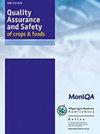热处理对棕色西班牙洋葱酱理化、植物化学和微生物特性的影响
IF 5.3
3区 农林科学
Q1 FOOD SCIENCE & TECHNOLOGY
引用次数: 4
摘要
洋葱酱是一种商业上使用的加工产品,可以减少烹饪时间。洋葱酱的工业加工涉及各种处理,这些处理会影响最终产品的整体营养状况。在本研究中,评估了不同热处理条件的效果,温度和时间分别在70 - 90℃之间,分别为8 - 22 min。研究了新鲜洋葱酱中槲皮素、丙酮酸的变化及其品质特性。槲皮素、丙酮酸、黏度、抗坏血酸和总平板数随温度和时间的增加呈负线性趋势。时间和温度的交互和联合作用与色差呈线性正相关。在本研究中考察的所有质量参数中,87°C 15分钟的热处理被发现是最适合货架稳定的洋葱酱的发展。槲皮素和丙酮酸含量分别为2.587±0.03 g kg-1和0.086±0.004µmol kg-1。与其他实验条件相比,最佳条件可以更好地保留主要化合物,并且与未经处理的样品相比,显示出更安全的质量产品。工业相关性:棕色西班牙洋葱是一种易腐烂的产品,由于高水分含量。为了减少国内和商业层面的采后损失,对洋葱酱的生产工艺参数进行了优化,具有经济效益,是深受消费者好评的产品。本文章由计算机程序翻译,如有差异,请以英文原文为准。
Effect of thermal treatment on physicochemical, phytochemical, and microbiological characteristics of brown Spanish onion paste
Onion paste is a commercially used processed product that reduces cooking time. Industrial processing of onion paste involves various treatments that affect the overall nutritional profile of the final product. In this study, effect of various thermal treatment conditions was evaluated, with temperature and time ranging between 70 and 90°C for 8 to 22 min, respectively. Changes in quercetin, pyruvic acid, and quality characteristics of fresh onion paste were investigated. A negative linear trend was observed in quercetin, pyruvic acid, viscosity, ascorbic acid, and total plate count, with an increase in temperature and time. An interactive and combined effect of time and tem-perature showed a positive linear relationship with color difference. For all the quality parameters investigated in this study, thermal treatment at 87°C for 15 min was found to be optimum for development of shelf-stable onion paste. Quercetin and pyruvic acid content were found to be 2.587±0.03 g kg–1 and 0.086±0.004 µmol kg–1, respectively. Optimum conditions depicted better retention of principal compounds as compared to the other experimental conditions and exhibited safer quality product as compared to the untreated sample.Industrial relevance: Brown Spanish onion is a perishable produce due to high moisture content. In order to reduce its postharvest losses at domestic and commercial levels, optimized processing parameters for the production of onion paste can be economically beneficial, and it is a highly acclaimed product for consumer usage.
求助全文
通过发布文献求助,成功后即可免费获取论文全文。
去求助
来源期刊

Quality Assurance and Safety of Crops & Foods
FOOD SCIENCE & TECHNOLOGY-
CiteScore
4.60
自引率
7.50%
发文量
61
审稿时长
1 months
期刊介绍:
''Quality Assurance and Safety of Crops & Foods'' is an international peer-reviewed journal publishing research and review papers associated with the quality and safety of food and food sources including cereals, grains, oilseeds, fruits, root crops and animal sources. It targets both primary materials and their conversion to human foods. There is a strong focus on the development and application of new analytical tools and their potential for quality assessment, assurance, control and safety. The scope includes issues of risk assessment, traceability, authenticity, food security and socio-economic impacts. Manuscripts presenting novel data and information that are likely to significantly contribute to scientific knowledge in areas of food quality and safety will be considered.
''Quality Assurance and Safety of Crops & Foods'' provides a forum for all those working in the specialist field of food quality and safety to report on the progress and outcomes of their research.
 求助内容:
求助内容: 应助结果提醒方式:
应助结果提醒方式:


